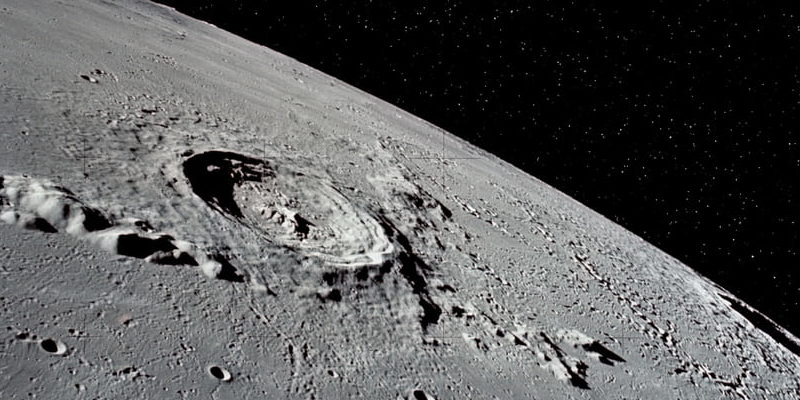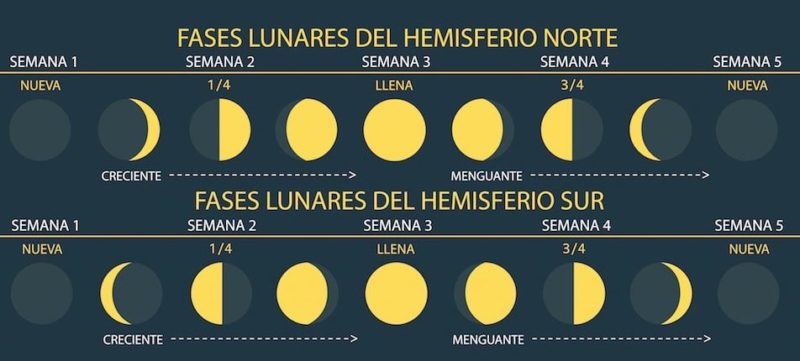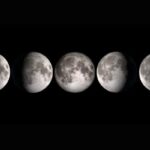We explain everything about the Moon, its formation, movements, relief and other characteristics. Also, its impact on the tides.

The Moon
The Moon It is the only natural satellite that orbits the Earth at a distance of approximately 385 thousand kilometers. It is the fifth largest satellite in the Solar System.
It takes 28 Earth days to go around the planet (translation movement) and rotating on its own axis (rotation movement) so that the same lunar face is always seen from Earth.
In 1609, the Italian Galileo Galilei (astronomer, philosopher, engineer, mathematician and physicist) built the first sixty-fold telescope, with which he discovered the mountains and craters of the Moon. In addition, he observed that the Milky Way was made up of stars and detected the four largest satellites of Jupiter.
On July 20, 1969, the American astronaut Neil Alden Armstrong was the first man to set foot on the Moon. So far, twelve humans have set foot on the lunar surface after several expeditions. In November 2009, the discovery of water on the Moon was formally announced, after an operation carried out by NASA.
Origin and formation of the Moon
There are various scientific theories that explain the possible origin of the Moon. The most recent theory is called the “big impact theory.” and postulates its formation four and a half million years ago, as the result of a major collision between Earth and Mars (when protoplanets were in their formation phase).
From the fragments that broke off from the collision, a celestial body was formed in which its magma melted until it crystallized and gave rise to the lunar crust. The star maintained its orbit around the Earth and became its natural satellite.
Other theories formulated in previous years are:
- Of binary creation It maintains that the Moon and the Earth originated in parallel, and that the satellite was the result of small particles that merged over thousands of years.
- Of the capture He maintains that the Moon was originally an independent planet that, due to the orbit and gravitational force of the Earth, remained as its satellite trapped in the Earth's orbit.
- Of fission It maintains that the Moon was separated from the Earth while the latter was in the process of formation and gradually solidified until it became the natural satellite. This theory was discarded due to the differences that both celestial bodies present in their composition.
Characteristics of the Moon

The Moon is a rocky celestial body. Its diameter is 3,474 kilometers (a quarter of the diameter of planet Earth) and is characterized by having a surface with deep craters and high mountain systems. It is mostly composed of oxygen, silicon, calcium, magnesium and aluminum.
Its atmosphere (called “exosphere”) is weak and light, so it cannot contain gases such as oxygen nor maintain its temperature, which oscillates drastically between 110º and -170º Celsius.
The Moon It does not shine with its own light, but rather reflects the light it receives from the Sun and that is why it can be seen from Earth and can be appreciated in its different instances or “phases”.
These phases are produced by variations in the position of the Moon with respect to the luminous star and the Earth, which generate more or less shadow on the satellite. The complete cycle that includes all the phases of the Moon is 29 days, 12 hours and 44 minutes, also called the “lunar month”.
Phases of the Moon

The phases of the Moon are the changes of the illuminated part which allow it to be appreciated in its entirety or in part. The same face is always visible due to the synchronization that exists between the time it takes to go around the Earth and to rotate on its own axis (both processes are carried out in 28 days).
There are four phases of the Moon and each one lasts about a week:
- New moon It occurs when the Moon is closer to the Sun, its illuminated part is not visible from the Earth and therefore is almost imperceptible from the planet.
- Crescent quarter It occurs when half of the Moon is illuminated: the right side is illuminated from the northern hemisphere and the left side is illuminated from the southern hemisphere. It occurs after the new Moon and it is possible to observe it in the afternoon and in the first half of the night.
- Full moon. It occurs when the satellite is most distant from the Sun and one of its faces is completely illuminated, so the Moon is seen completely from the Earth throughout the night.
- Last quarter It occurs when half of the Moon is seen illuminated, but in a decreasing manner (unlike the crescent Moon) and the visible half varies depending on the Earth's hemisphere from which it is observed. It is possible to see it at dawn and in the morning.
Moon relief
The surface of the moon was studied through several expeditions (both manned and unmanned) carried out during the years 1969 and 1972.
From the samples obtained, it was verified that It has a solid, rocky soil with a multitude of debris, craters and basins. Among other reasons, the accidents of its relief are due to the fact that it does not have a consistent atmosphere that protects it against the impact of asteroids or other smaller celestial bodies.
It has mountains up to 9,140 meters high and some volcanoes that are inactive for millions of years. It is estimated that, in addition to the mountain ranges, the plain areas or plateaus correspond to old seas, the largest detected being 1,120 kilometers in diameter.
There are also deep valleys called “lunar fissures” that reach 480 kilometers long and 3 kilometers wide. It is estimated that they were formed as a result of the heat and expansion originating from the interior of the satellite.
Moon Movements

The moon makes two primary movements:
- The translation It is the movement of the satellite around the Earth, which takes 28 days, that is, approximately one month. In addition, it carries out the translational movement around the Sun.
- The rotation It is the rotation of the satellite on its own axis and towards the east that it also performs in 28 days.
The Moon's orbit is inclined at a different angle than that of the Earth and the Sun, so solar and lunar eclipses can only occur at two points in its path, respectively.
When the satellite aligns exactly between the Sun and the Earth, a lunar eclipse occurs (it occurs when the planet comes between the luminous star and the Moon).
the tides

The Moon's gravitational force influences the tides on Earth. When both stars are at a close distance, part of the mass of terrestrial water that is facing the Moon is attracted to it and the flow of terrestrial water increases.
The Sun also influences the tides due to its gravitational force, but to a lesser extent due to its distance from the Earth.
The tides do not always vary at the same time, but depend on the phases of the moon and its alignment with the Sun. They can be:
- Spring tides They are those high tides that are generated with the new Moon, in which the satellite and the Sun align, merging both gravitational forces.
- Neap tides They are those small tides that are generated during the waxing and waning phases of the Moon.
Continue with: Artificial satellites
References
- “A multiple-impact origin for the Moon” on Nature.com
- «New theory about the origin of the Moon» in MuyInteresante.es
- «Moon» in Naturaleza.paradais-sphynx.com
- «Movements of the Moon» on Astronomia.com
- “Moon phase” on Wikipedia.org





